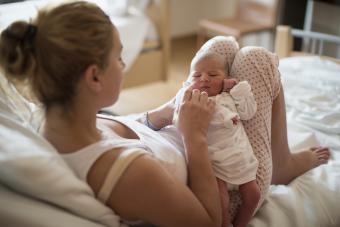
Recommended maternity leave can vary depending on your personal health and family circumstances. It can be helpful to gather information and make a plan for maternity leave during your first or second trimester so that when the baby arrives, you can focus on building your family and bonding with your newborn. In some cases, the recommended maternity leave starts before your baby is born
Average Recommended Maternity Leave
In the U.S., there is not really a recommended maternity leave time for childbirth or parenting a newborn. What we have in the U.S. is known as maternity leave laws from the Family and Medical Leave Act (FMLA). OSHA states that by law, "Covered employers must grant an eligible employee up to a total of 12 work weeks of unpaid leave during any 12-month period." This leave time is available for maternity leave.
Most women can safely continue to work while pregnant. Your job shouldn't prevent you from taking good care of your health or stop you from getting enough rest. However, in most cases, as long as you feel good, your care provider will likely give you the go-ahead to continue working as long as you feel comfortable.
Some women take a couple of weeks off before their due date, while others work right up until the day before they give birth. Honestly, it's probably best to take at least a week off before your due date. Even if you feel healthy, you need to get plenty of rest to prepare your body for labor, childbirth, and taking care of your newborn.
Maternity Leave Considerations
While there are guidelines for maternity leave, the recommended maternity leave for you may depend on a few factors related to your specific job, your medical status, and the health of the baby
Safety At Work
If you have a high risk job or a job where you must handle dangerous materials, you may need to be transferred to a desk or other type of job with the company during your pregnancy or find a different job. Most companies and FMLA have rules about transferring, or making reasonable accommodations for pregnant women, but not all companies follow those rules.
The March of Dimes provides helpful information about some of the dangers you should avoid during pregnancy. If you can't avoid these things because they're at your workplace, then an early leave might be in order.
- Rodents such as in a lab or pet store.
- Constant heavy lifting, such as you might run into with warehouse work.
- Toxic fumes and chemicals that may enter your system and affect fetal development. Although, you can also wear face masks and other protective equipment at most workplaces.
- Mercury should be avoided, which might be breathed in if you work with certain industrial equipment or if you work at a place that burns coal or other waste materials.
- A job that requires you to stand all day long with few breaks.
If you're concerned or have questions about your workplace safety, you can complete a workplace pregnancy risk assessment.
Medical Issues
Recommended maternity leave for a woman can be longer if she has a health issue that is negatively affecting her pregnancy. This is normally called a "high risk pregnancy" by care providers. Many companies will allow extended maternity leave if they have the medical provider's documentation of the problem. Some health conditions that tend to warrant extended leave include any condition that requires bed rest or extra care. Some pregnancy related problems that may require more than average maternity leave include:
- Advanced anemia
- Bleeding (more than spotting)
- Carrying multiples
- Gestational diabetes
- Hypertension
- Incompetent cervix
- Infection
- Lower than average amniotic fluid
- Placenta previa
- Possibility of a miscarriage
- Preeclampsia or eclampsia
- You're showing signs of preterm labor
- Your care provider is certain that you'll have a premature birth
Another concern for pregnant mothers is stress, but determining the severity can be subjective. If you're experiencing added stress such as grief caused by a death in the family or major relationship issues during late pregnancy, early maternity leave may be recommended.
Also, if you have a child (or children) already, you may want to consider an extra week off. It can be hard on both children and parents to bring another baby into the house, and the extra time allows everyone a bit more time to prepare.
Returning to Work
The best time to return to work for you is going to relate directly to your personal physical health and emotional feelings about returning to work. You need to consider how long you'd like for bonding with your baby, the time it takes to establish breastfeeding if you plan to do so, and any health concerns.
As far as health goes, many women physically can return to work within a few weeks of giving birth. Six weeks is typical after-baby maternity leave in the U.S. Many women end up wishing they had more time, though. If you can afford it, and your company allows it, take as much time as you can to feel comfortable with your new parenting role.
Keep in mind that some companies require a care provider's note that gives you an okay to return to work, so check with your human resource department. Also, FMLA does not mean that you have to take all 12 weeks at once. Some workplaces allow you to come back part-time at first, or let you take one extra day off per week, using your FMLA time. Not all employers offer good options like this, but it's something to consider and ask about.






